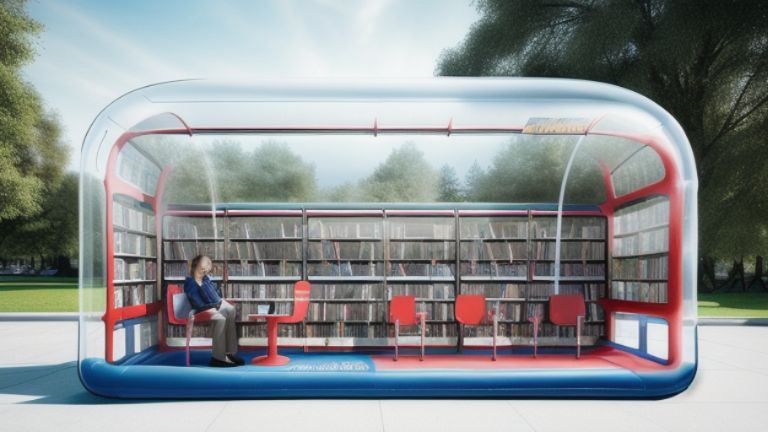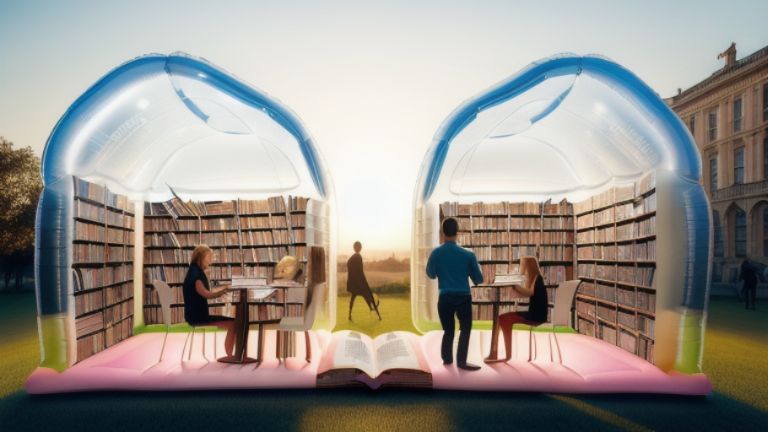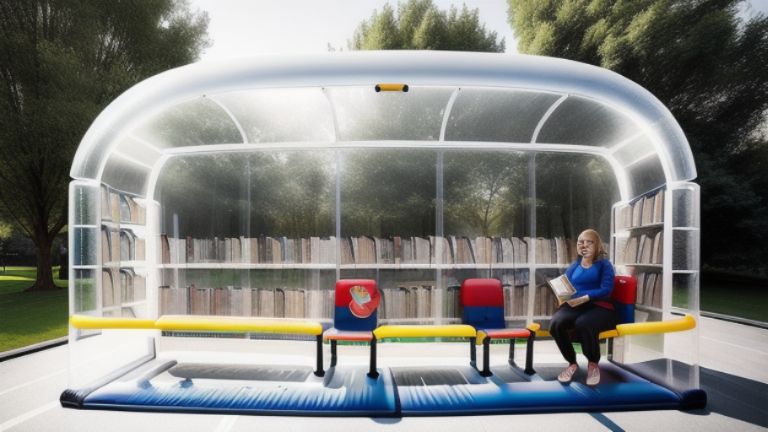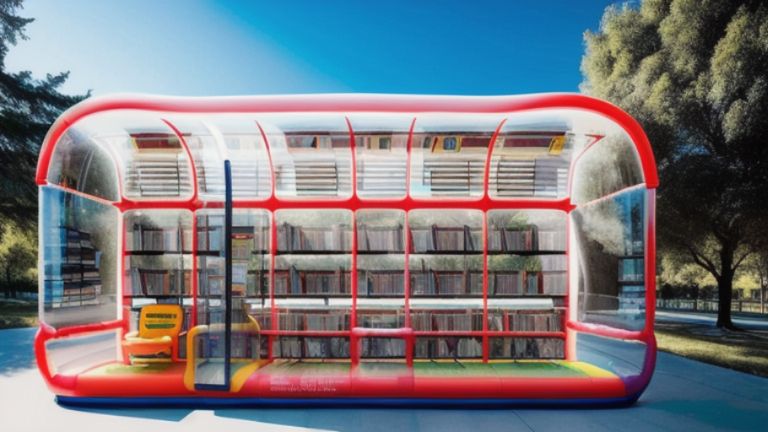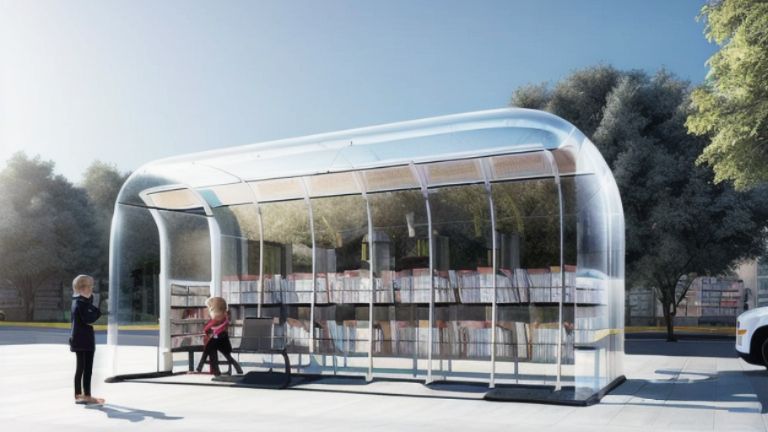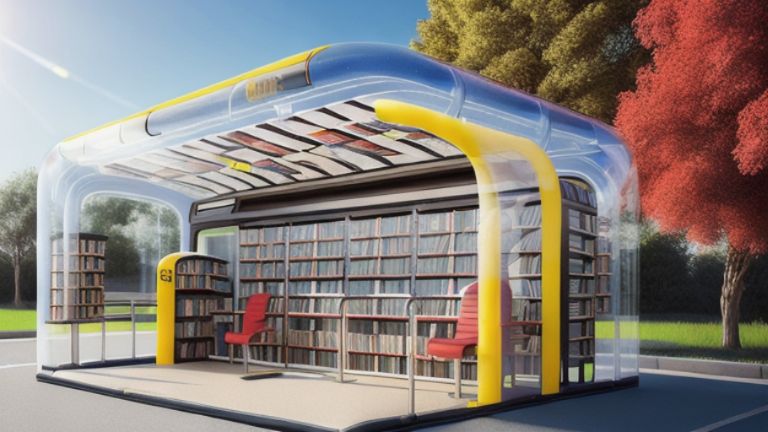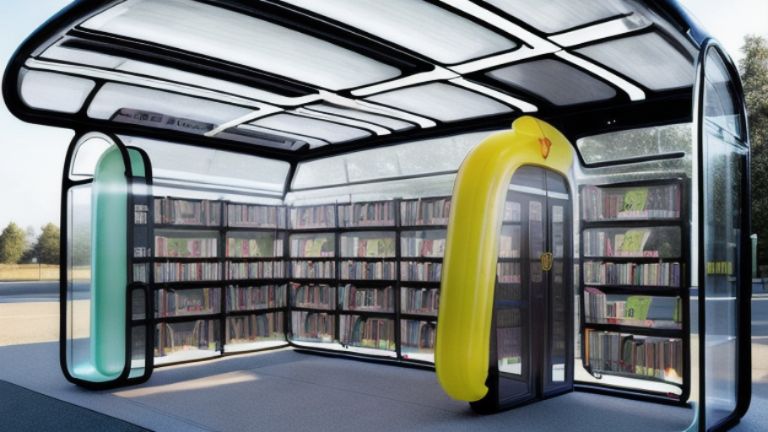As our cities grow ever more crowded, architects and designers are exploring innovative new ways to create public spaces that serve multiple purposes. I’m always looking for new stimuli and ways of seeing and doing design and architecture, and with the advance of technology, I’d like to give space to some “technomorphic design suggestions” – or design evolutions shaped by technology in the widest possible meaning. A spot-time between design and cultural provocations. A very provocative concept concerns the bus stop library, a new type of pop-up architecture design that combines the utility of a bus stop with the educational benefits of a library – I am testing this as a sort of Human-AI Co-Creation exploration.
Have you ever imagined reading a book at a bus stop? What if the bus stop itself was a library?
I tried to revert this idea suggestion below:

But what if the bus stop library could be made even more versatile, more eye-catching, and more fun?
That’s where the inflatable balloon comes in.
Picture this: a giant, brightly coloured inflatable balloon, big enough to be seen from blocks away, bobbing gently in the wind at a busy intersection. As you get closer, you realize that the balloon is actually a bus stop library, filled with books, magazines, and other reading materials.
The balloon is made from a lightweight, durable material that can withstand the elements, and it’s anchored securely to the ground to prevent it from flying away. The interior is spacious and airy, with plenty of seating and shelving for books.  But the real magic of the bus stop library balloon lies in its ability to transform public spaces. Because it’s portable and can be set up quickly, it can be moved from location to location, bringing books and educational resources to different neighbourhoods and communities. And because it’s so visually striking, it’s sure to attract attention and draw people in, creating a sense of excitement and community. But the bus stop library balloon isn’t just a fun novelty. It’s also a practical solution to a real problem. Many neighbourhoods lack access to libraries and other educational resources, and for some people, the bus stop is the only place they can go to get around. For instance, in rural or remote areas, where transportation and infrastructure are limited, inflatable libraries can serve as mobile units that can travel to different villages and communities. Similarly, in urban areas, where space and resources are scarce, inflatable libraries can occupy unused or underutilized spaces, such as parking lots, sidewalks or parks, and transform them into vibrant and inviting places for reading and socializing. By combining the two, the bus stop library balloon provides a valuable service to the community while also promoting literacy and learning, finally, by creating a common space for people to gather and exchange books, ideas and experiences, inflatable libraries can promote a culture of reading and learning that transcends boundaries and backgrounds.
But the real magic of the bus stop library balloon lies in its ability to transform public spaces. Because it’s portable and can be set up quickly, it can be moved from location to location, bringing books and educational resources to different neighbourhoods and communities. And because it’s so visually striking, it’s sure to attract attention and draw people in, creating a sense of excitement and community. But the bus stop library balloon isn’t just a fun novelty. It’s also a practical solution to a real problem. Many neighbourhoods lack access to libraries and other educational resources, and for some people, the bus stop is the only place they can go to get around. For instance, in rural or remote areas, where transportation and infrastructure are limited, inflatable libraries can serve as mobile units that can travel to different villages and communities. Similarly, in urban areas, where space and resources are scarce, inflatable libraries can occupy unused or underutilized spaces, such as parking lots, sidewalks or parks, and transform them into vibrant and inviting places for reading and socializing. By combining the two, the bus stop library balloon provides a valuable service to the community while also promoting literacy and learning, finally, by creating a common space for people to gather and exchange books, ideas and experiences, inflatable libraries can promote a culture of reading and learning that transcends boundaries and backgrounds.
Of course, there are challenges to implementing a design like this. inflatable libraries also pose some challenges and limitations that need to be addressed. One of the main issues is the durability and safety of the inflatable structures. Since they are exposed to various weather conditions and potential damages, they require regular maintenance and repair. Furthermore, they need to comply with local regulations and standards regarding fire safety, accessibility and security. Another challenge is the selection and distribution of the books. Depending on the context and the audience, the inflatable libraries need to provide a diverse and relevant collection of books that can cater to different ages, interests and languages. Additionally, they need to ensure that the books are returned or exchanged in a timely and orderly manner. As our cities continue to grow and evolve, it’s exciting to see how innovative new designs like this can help us create more vibrant, inclusive, and engaging public spaces for everyone to enjoy.
As I mentioned earlier, many neighbourhoods lack access to libraries and other educational resources. Too often, bus stops are drab and uninviting, offering little in the way of amenities or visual interest (maybe except in Dubai 🙂 ). By contrast, the library balloon is bright, colourful, and eye-catching, creating a sense of excitement and community pride. And because it can be moved from location to location, it can help activate underutilized public spaces and create new gathering places for people to connect and socialize.
The concept of a pop-up library inside an inflatable pavilion is a natural extension of the bus stop library balloon idea. Instead of a balloon anchored to the ground, the library would be housed inside a larger, more permanent structure that can be easily inflated and deflated as needed. Inside the pavilion, the pop-up library could be designed to offer a wide range of resources and
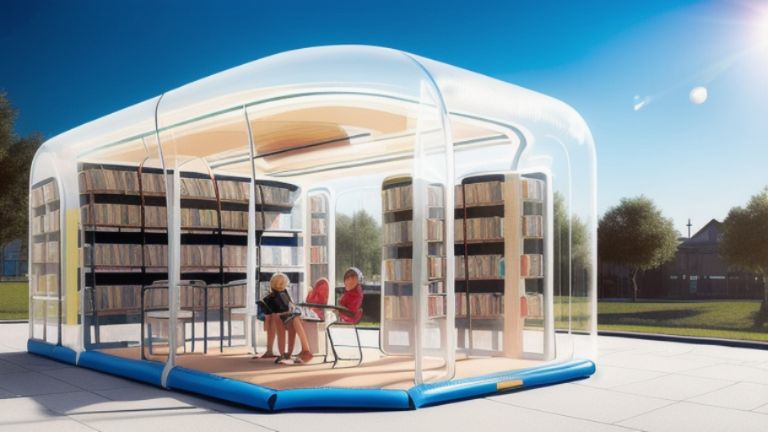
amenities. In addition to books, it could include educational materials, computer stations, and meeting spaces for community events and workshops. By offering these resources in a central, accessible location, the library can become a hub of activity and learn for people of all ages.
In conclusion, inflatable libraries are an innovative and provocative way of reimagining architecture and design as tools for social change and cultural enrichment. They offer a flexible and adaptable solution for providing access to books and literacy in various contexts and locations. However, they also face some challenges and limitations that need to be considered and overcome. Inflatable libraries are not only spaces for reading, but also spaces for dreaming, creating and connecting.

